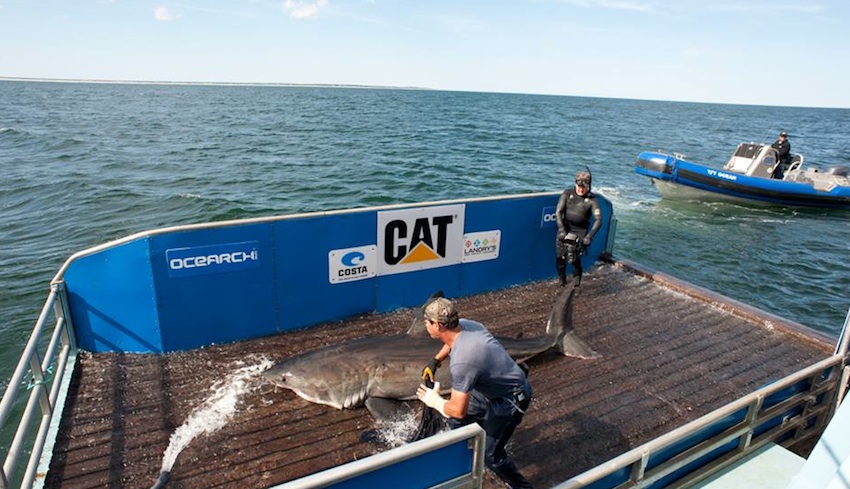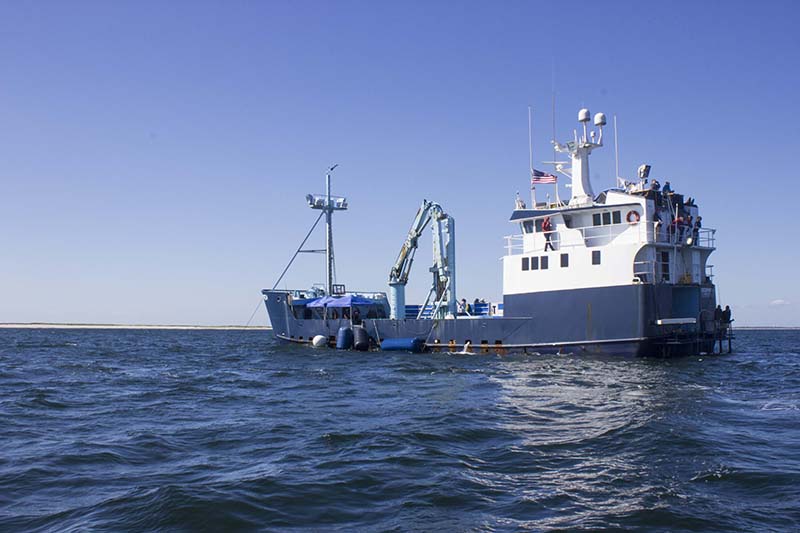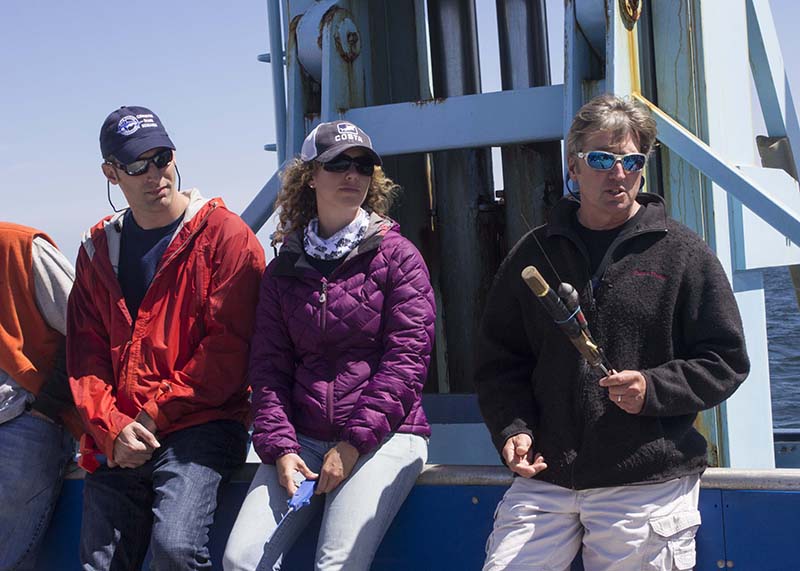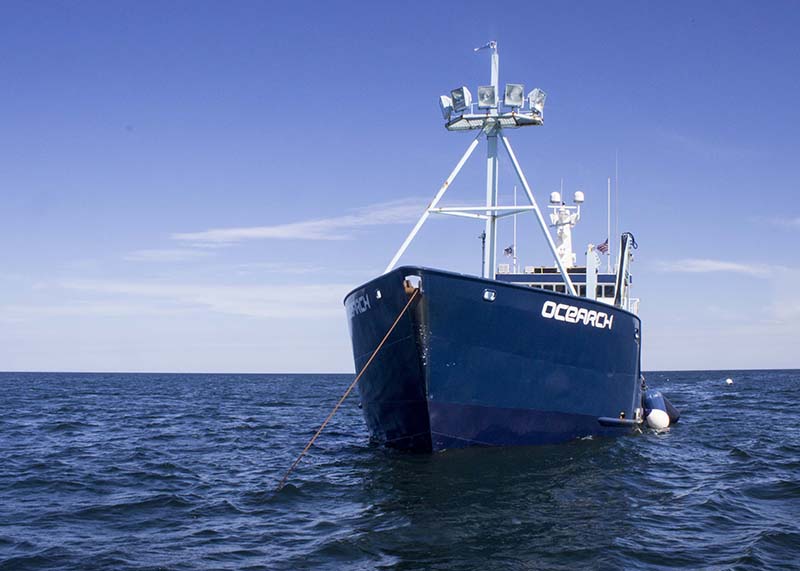Lions of the Ocean
Bob Yates doesn’t mind eating his lunch next to the chopped-off heads of bluefin tuna, with their black, bulbous eyes staring back at him as he shovels a plate of pasta into his mouth.
It’s part of his job—just another day as the captain of the M/V OCEARCH off the coast of Chatham—where he helps further the research and tagging of Great White sharks alongside some of the nation’s top marine biologists. “You get used to it. The smell isn’t that bad,” Yates says before scooping pieces of chum onto the edge of a butcher knife and tossing them into the water.
Yates, who’s been doing this for decades, uses the chum to create a “slick line,” a mixture of oils, fish heads, and chunks of other bait to entice Great Whites toward the ship so the OCEARCH team can wrangle the sharks onboard for examination and tagging.
Since the ship launched for the 2013 season on July 31, members of the OCEARCH team have spotted 13 sharks off Cape Cod and successfully tagged just one so far. That total just trails the two sharks the team of OCEARCH researchers—led by Dr. Greg Skomal and founder Chris Fischer—wrangled the year before in the Monomoy National Wildlife Refuge near Chatham. It’s also fewer than the 15 Great Whites tagged in the waters last summer by state researchers along with Skomal, who used harpoons to insert a sensor into the sharks while they swam below.
Researching and tagging sharks by bringing them onboard is certainly more difficult, but the OCEARCH team is able to attach more sensors and collect more data than if they just used harpoons. “I have been a scientist for 30 years studying animals that are really hard to get ahold of. If you study sharks, it’s expensive, and they are a rare event species, and it’s not always predictable or easy,” says Skomal, the state’s top shark expert who has worked with Fischer on OCEARCH for the last two years. “I don’t set my sights too high when it comes to working in this field. If you get 10, you get 10. If you get one, you get one.”
And get one they finally did. On Thursday afternoon, the team brought in a 12-foot, 1,400-pound female. They named her Betsy. “Just one shark tagged will contribute immensely to what we know about this species because we just don’t know that much,” says Skomal.
Like Skomal and Fischer, Yates doesn’t let the amount of taggings overshadow the reason for being there. This team of scientists, along with a number of deck hands, has an important job to do, and as Fischer tells the crew, “a lack of numbers doesn’t mean there was a lack of effort.”
“Even if we just see one, it can be exciting,” says captain Yates, a tattoo of an anchor stamped on his forearm. He then churns a pole in a large bucket, releasing bits of dead fish back into the sea.
Aboard The M/V OCEARCH
Historically speaking, Great Whites come to Monomoy in large numbers during the month of August, according to data kept by Skomal for nearly a decade. Great White sightings off the Cape this summer started in July, when an independent group of shark spotters saw a 14-footer swimming in the bay from a helicopter.
Going further back, the sightings in Massachusetts started to increase in 2004 when a Great White wound up in Wood’s Hole, baffling Skomal and other state researchers at the time, and intensifying the need to study the sharks with new fervor. The sighting was out of the ordinary, and was the first of what would become a pattern of frequent appearances each season that would eventually bring Skomal and Fischer together.
Before that, however, Skomal got his start tracking Great Whites by renting vessels equipped with tagging harpoons so researchers could follow their migratory patterns. This method of research only scratches the surface of what scientists want to conquer in order to take a deeper look at the habitat and patterns of behavior of the “lions of the ocean,” as the crew calls them.
In 2010, OCEARCH wound up on Skomal’s radar, with its lead expeditionary, Fischer, offering the state a new way to learn about and examine the sharks. Skomal, who wanted to figure out why the sharks were suddenly cropping in record numbers, was intrigued. “We have been tagging since 2009, so our research didn’t start because OCEARCH was here, but it has just been augmented, so to speak. It’s another platform,” says Skomal. “And with such a great platform being offered to me, it’s hard to say no to that.”
After chatting throughout the next two years, in 2012, Fischer brought OCEARCH to Chatham to begin working with Skomal.
The latest OCEARCH expedition off Monomoy is said to be the largest of its kind, and it’s scheduled to run through August 29, with the goal of bringing onboard between 10 and 20 Great Whites, although Fischer hopes to extend their stay in the area through the first weeks of September due to the low numbers so far. That decision is based on the current location of some Great Whites off New York and Florida, which may suggest they haven’t arrived en masse to the Massachusetts bay just yet.
The ship is equipped with a custom 75,000-pound hydraulic lift and at-sea laboratory, something no other research ship in the world has. When they finally have a shark in sight, like they did on August 15, after teasing it with chum, they use the lift to haul the shark in before using cutting-edge technology to help further their studies. “They are like the Holy Grail of the sharks—to study white sharks, it’s a dream come true,” Skomal says.
How to Tag a Great White
Just after 1 p.m. on Wednesday, August 14, an entire day before the crew would capture the first Great White of the season, the energy on the 126-foot vessel was dull. It had been more than eight long days at sea with just a few sightings and a couple of curious nibbles at the back of the boat where Yates often camps out for hours, tossing fish guts into the water.
For the most part, crew members never really leave the OCEARCH boat, which is camped out roughly 25 minutes from the Chatham shores. From 4:30 a.m. until dinner time, the crew spends their hours trying to attract sharks and keeping lookout until they retire for the day. Then, the next day, it starts all over again. Some crew members stay on for weeks, months at a time. It’s a routine Yates says he’s accustomed to. “We all work together, and take turns doing different things,” he says.
After a long day of patiently watching the ebb and flow of the waves surrounding the boat in all directions, searching for any sign of a dorsal fin between the white chips of ocean, the energy suddenly shifts, coming to life as Skomal steps on board the OCEARCH platform. Skomal appears with family and friends of the crew, bringing a vibrancy that injects life into the mundane morning that was met by the usual tasks bestowed upon the scientists and workers.
After diving into a lunch prepared by an onboard chef—who cooks up enough food to feed the 45 people on board—Skomal doesn’t hesitate to start talking about his passion for tracking and tagging Great Whites. “When we are tagging a shark, we have 15 minutes to get it done and make science happen,” he says, standing on the strip of dock connected to the lift.
Even without a catch that day, Skomal appears animated as he describes the step-by-step process for attaching a tracking device to the shark. “It all happens fairly quickly, and we need to make sure it all happens accurately,” he says, referencing the small window of time the group has to fasten three separate devices to the outside of the shark’s body, and one inside its abdominal cavity.
Anywhere up to nine workers—some holding the head, others holding the tail—will jump into action while a shark is on the ship’s lift. A scientist will race to draw blood from the shark, which allows researchers to examine the nature of the species without having to kill it to learn more. “In my 30 years, a lot of that time I spent studying dead fish,” said Skomal. “But in that instance, you learn nothing about the animals’ behaviors. Having access to live sharks allows us to learn about them in their habitat, and study the physiology and health of the animal in real-time.”
During a tagging session, as one scientist takes blood samples, Skomal gets to work. After making an incision in the shark’s abdominal wall, he then inserts a small acoustic transmitter inside—they “barely twitch,” he says—which will later help researchers monitor the activity and local movements near Chatham using a high-frequency ping picked up by receivers. Skomal has tagged his fair share of sharks. Skomal and state researchers, using the harpoon methods, tagged five sharks in 2009, six in 2010, seven in 2011—all before their time with OCEARCH—and then 15 in 2012. Two additional sharks that year, Mary Lee and Genie, were tagged on the OCEARCH vessel, bringing the total to 17.
Following the insertion of the transmitter, marine biologist Mike McCallister, who spends many mornings at the top of the ship, scouting the horizon for sightings, steps in with an ultrasound device to scan along the shark’s belly, if she is female, to determine whether or not she is pregnant. The device also lets McCallister observe the intestinal tracts and other organs inside the shark to generate an overall assessment of its health. “Hopefully it will allow us to get images of pups or the eggs that could be fertilized, and that may lead us to finding the spot where the shark may be mating,” McCallister says.
During these critical moments of research, a small, blue sensor is fastened to the dorsal fin, which allows researchers to track where it is every time it surfaces and pokes above the water. Meanwhile, a larger orange “accelerometer,” one that Skomal calls “the latest and greatest” in technology, is also attached to the fin. The accelerometer tracks GPS and other data on the shark’s lifestyle—like its movements and hunting habits—then, on a timer, detaches from the fin so the researchers can scoop it from the water. The third and final sensor, inserted into a muscle at the base of the dorsal fin, utilizes a satellite linkage signal to send emails to Skomal’s team so they can recreate 3-D movements like swimming depths. “No one else is doing this. No one else is using this level of technology,” says Skomal, grinning from ear to ear. “We no longer have to kill the fish to study it. That’s old school, classical fisheries and biology at its finest. Now we have the latest tools to [advance our research].”
Data compiled and collected by researchers is then uploaded to a database called the Global Shark Tracker, so that the public, far away from the ship as it bobs along Monomoy Bay, can learn about the predators’ habits in real-time. This part of the project—giving the public access to information about sharks—is arguably the most important to Skomal and Fischer. In a way, it’s the glue that binds them together, bringing their fascination with ocean life to other scientists as well as the masses.
The Show Must Go On
Fischer is always easily excited when talking about sharks.
When asked about OCEARCH, there’s a level of positivity and a flow of ideas that come from Fischer’s mouth that shift more rapidly than the ocean surrounding his ship.
The founder and brains behind the project, Fischer’s days as a Great White researcher seem a little unlikely for a guy who was born and raised in Louisville, Kentucky. It wasn’t until he attended college in California that his love for fishing would blossom as he’d spend days at a time on the ocean. After college, he returned to his hometown, where his family owned a lucrative business selling devices that dispensed soda products—something Fischer had begrudgingly accepted as his fate to take over. Around that time, the family sold the business, and he found himself asking, “now what?”
Fischer says he returned to California, a 29-year-old without a plan, and decided to do what he does best. “I went fishing,” he says.
Something changed one day when he returned from the water. When he talked with friends about his days spent ocean fishing, he says their attitude toward the environment baffled him. “They would say ‘OK, great, now lets go get dinner,’” Fischer says, gathering his thoughts. “I thought, ‘if these people are not connected about what’s going on in the ocean, and they live on the beach of California, then what about people back in Kentucky?’”
That’s when he decided to start a video production company called Fischer Productions, which would bring his love of the ocean to mainstream media. He started with television shows, but quickly learned that being the “fishing guy” wasn’t going to move the needle on a global scale. To do that, he needed to become the “greatest ocean explorer of our time.”
“I thought I saw a path to do that,” says Fischer. “We began supporting more scientists and bringing these fishermen together with scientists, and created this collaboration that everyone felt secure in. It just began to build and build.”
When he started doing work on OCEARCH, he thought he could build a global brand, and take some of the money to fund the research and a television show. OCEARCH—four years before it came to Massachusetts to work with Skomal—was featured on an Emmy-winning show hosted by Fischer called “Offshore Adventures,” which aired on ESPN from 2002 to 2008. In 2009, Fischer became the star of two television series: “Shark Men” on National Geographic, which later became “Shark Wranglers” on the History Channel. Fischer was able to realize part of his dream, bringing his work with sharks to millions of people right in their homes.
So he thought. It turns out that filming a TV show on your boat also means allowing a TV network to stage fights between your crew, which, according to Fischer, took away from the task at hand. “I was on a mission. I was trying to affect the future of the ocean on a global scale, and in order to do that, I need to be able to be spending time with policy makers and presidents, and you can’t do that if you are the fool starting fights on TV on a Thursday night,” Fischer says. “If you want to affect great change on a great scale, you have to do it the right way.”
Both shows came to an end, leaving Fischer without a steady flow of funding. “I was scared to death,” he says. “But I said screw it, and scraped the last of my money together last fall for the trip [to Chatham], and said if it doesn’t work, I’ll write a book. Or get a job.”
The silver lining turned out to be that, without the strings attached to OCEARCH in the form of exclusive TV contacts, Fischer now was able to invite anyone he wanted onto the boat to film and capture footage. “It started to inspire people, and they started to want to become a part of it,” Fischer says. “Then we gave our [research] data away, and all of the sudden everyone was involved, and our scale went from 35 million people a year on TV, to just last year, when we came here for one month and invited the global press, we did 120 million earned media impressions. And instead of paid media on TV with conflict and characters, it was newspaper articles and shows about pioneering research to create a sustainable planet for the future while we educate our kids.”
This, in turn, opened up the world to the species, and it saved Fischer’s ship. Endorsements from companies like Caterpillar started pouring in, helping keep Fischer’s dream of getting the word out about his research alive. “[Caterpillar] asked for nothing. So now what happens, with them funding us, we can give it all away, and we are 100 percent on mission all of the time,” he says. “Everyone gets it now. It’s just about the sharks and the ocean, and it’s the future. We have disrupted the institution for this research. And we are getting ready to disrupt education.”
The move away from network TV is also what brought Skomal and Fischer together to conduct research off of Cape Cod for the last two seasons. Skomal shared a common approach to how he wanted people to learn about the ocean, and the importance of getting that information to as many people as possible. “Studying things is great and satisfying myself is fine, but what good is it if you don’t share it with other people? I think people are fascinated by these animals, and the more fascinated they are about the Great White and the ocean, the better,” Skomal says as the day winds down. “To be able to share that and bring the public into the fold and get them interested and get them fascinated, the more likely they are to consider the preservation of our natural resources.”
With the attention of the world—OCEARCH does expeditions all across the globe—at his beck and call, Fischer now wants to turn the shark experience into something bigger. “We are bringing exploration into the now, we are bringing science into the now, and filmmaking into the now. So I feel like, my biggest problem is people think I catch sharks … but you need to see beyond that,” he says. “We captivate them with the shark, and next thing you know, they are learning their math, their physics, their geology, and in today’s world, they have to have that. The compelling nature of the White Shark creates this chain of events that’s like a giant circle, all of them benefitting one another and trying to create this perpetual funding for field-based research that’s shared with the world 100 percent on mission all the time. And suddenly, everything is benefitting everything else.”

DR. ROBERT HUETER, ONE OF THE SCIENTISTS ABOARD THE OCEARCH SHIP / PHOTO BY OLGA KHVAN

Nick Whitney, staff scientist at Mote Marine in Florida, shows off an accelerometer / Photo by Olga Khvan

THE CONTENDER, A SMALLER FISHING BOAT USED BY OCEARCH, ABOUT A MILE AWAY FROM THE MAIN SHIP / PHOTO BY OLGA KHVAN

SOME OF THE OCEARCH CREW ABOARD THE SHIP / PHOTO BY OLGA KHVAN








